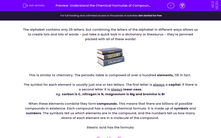The alphabet contains only 26 letters, but combining the letters of the alphabet in different ways allows us to create lots and lots of words - just take a quick look in a dictionary or thesaurus - they're jammed packed with all of these words!

This is similar to chemistry. The periodic table is composed of over a hundred elements, 118 in fact.
The symbol for each element is usually just one or two letters. The first letter is always a capital. If there is a second letter it is always lower case.
eg. carbon is C, nitrogen is N, magnesium is Mg and bromine is Br
When these elements combine they form compounds. This means that there are billions of possible compounds in existence. Each compound has a unique chemical formula. It is made up of symbols and numbers. The symbols tell us which elements are in the compound, and the numbers tell us how many atoms of each element are in a molecule of the compound.
Stearic acid has the formula:
C18H36O2
This means it contains 18 atoms of carbon, 36 atoms of hydrogen and 2 atoms of oxygen in a molecule of stearic acid. Woah that's a lot!!!
The little numbers (the subscripts) only tell us how many atoms of the element whose symbol is just before the number. If a symbol doesn't have a little subscript number after it then it means there is only one atom of that element.
Let's have a go at some questions about chemical formulae.
You might find it helpful to have a paper copy of the periodic table in front of you for these questions.
.jpg)








